Last night in Toronto, the Director’s Guild of Canada put on a one-night-only special presentation with the Star Trek: Discovery art department, where the creative experts behind the show’s 23rd Century look spent an hour answering fan questions and showcasing never-before-seen production concept art to the assembled crowd.
While we’ll bring you some of the details from that event in a future report, we first want to share with you our extended interview with the head of the Discovery art department: production designer Tamara Deverell, who joined the show early in the first season and continues to lead the team into Season 2.
Responsible for overseeing all the sets, artwork, props, and everything else you see on-screen for Discovery is a massive job, but Deverell has lent her expertise to helping to create last season’s visit to planet Pahvo, the gold-plated Terran Empire, and the dark and gloomy Orion outpost on Kronos — and this year continues to expand the look of Discovery with the arrival of Captain Pike and the journey into the world of the secretive Section 31.
We caught up with Deverell before last night’s presentation, for a conversation made possible thanks to the Ontario division of the Director’s Guild of Canada.
Note: Portions of this interview have been condensed or edited for clarity.
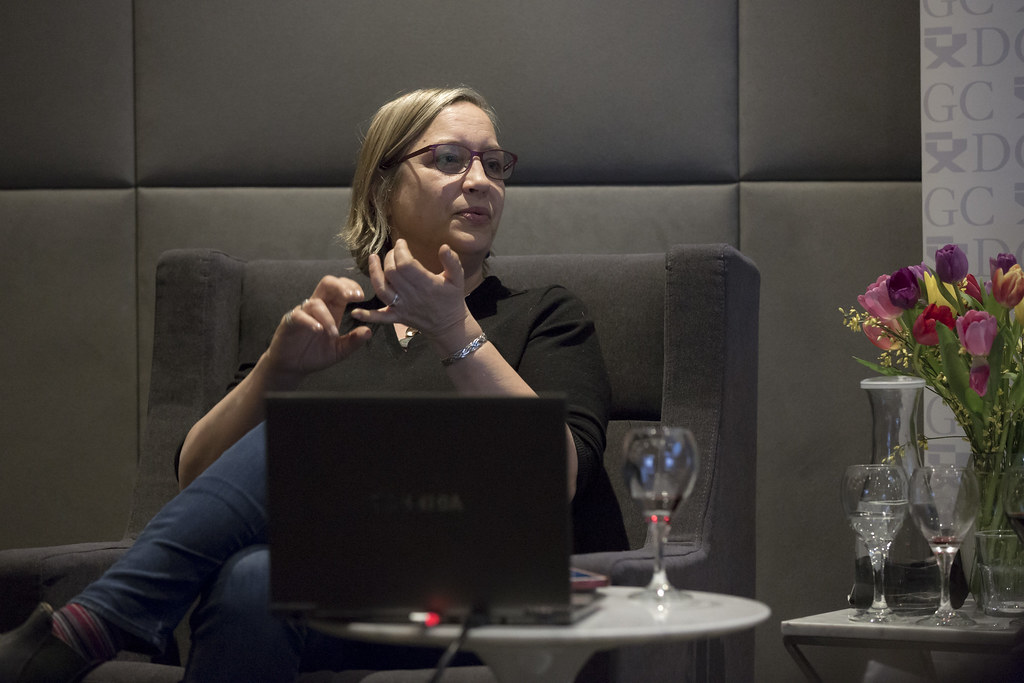
TREKCORE: For those who may not be so familiar with the role of ‘production designer,’ how would you describe your position in the Star Trek: Discovery team?
TAMARA DEVERELL: Well, I’m the head of the art department, so everything visual comes through me. As you can imagine on a show like Star Trek, we are designing with a very large art department, and you’re really running that department, trying to connect with what the writers and directors need to tell the story.
Really, I’m sort of the pinch-point between the writers room and above-the-line creative team to the art department, which includes the sets, set decoration, prop design, visual effects, concept artists developing designs we need to see before we build parts of sets to be extended by visual effects…
The art department really is made of the architects of the show, drawing and building and conceptualizing everything. Practically every set is a physical build – unless we go to a place like the quarry for the rebel planet [Harlak] – it’s a studio-heavy show.
TREKCORE: You started on Discovery with “Magic to Make the Sanest Man Go Mad,” after the primary standing sets had been established. Was it difficult to take over midway through the season, when the look of the show had already been determined by other artists?
DEVERELL: I mean, that was one of the first questions I asked the producers who wanted to hire me. “Do I get to do anything new, or will I be babysitting somebody else’s work?” And they assured me, “Most definitely, we’re constantly going to new places and new worlds.”
It helped that a lot of the crew already working on the show were people I had been working with [on other projects], so I was very comfortable, and didn’t come into work with a bunch of strangers. As for the standing sets, I was able to go in and – respectfully, of course – make some changes, in concert with the producers and directors.
Through Season 1, and especially going into Season 2, we altered a few things. A lot of that was just for practical reasons – things you might not see – just to make the sets easier to work on for the crew, like [removable] walls, and some other technical things.
When I came into the show and my predecessor, Todd Cherniawsky, toured me around the sets, I said, “Of course I want a piece of this action.” They’re just gorgeous sets. But I’ve come into other shows midway, it happens a lot – and you sort of just make it your own, after a while.
This is the agonizer set ONE DAY before it was supposed to shoot.Thought we were https://t.co/uFUXD7tYnn up the next morning and set is perfect. Art always hits their deadlines, prod doesn’t make it easy. @tamaradeverell and her art dept. are INCREDIBLY important to this show. pic.twitter.com/5u4sSuLjMo
— Olatunde Osunsanmi (@CenterWillHold) February 2, 2018
TREKCORE: How well did you know Star Trek before joining the Discovery team?
DEVERELL: I grew up watching the Original Series – I’m that old! (Laughs) I’m not a ‘Trekkie,’ but I don’t think that’s necessary to do the job, you know? I’m a professional production designer, and I very consciously decided not to immerse myself in Star Trek when I started.
I felt like that would hinder my vision of what I could bring to the show – and I knew TOS, and I saw enough of some of the other shows as I got older, but I can’t say I’ve watched every episode or every part of the franchise.
TREKCORE: How does that knowledge of Trek influence your designs?
DEVERELL: I mean, there are certain nods you want to make, especially in Season 2 – which of course I can’t talk about yet – but there were very specific [moments of] going to look at the canon and going, “Oh, that’s something I really want to emulate,” or echo, or you know, play with. A lot of people ask how we get away with doing a show that looks so much [more futuristic] than TOS, but predates it?
That’s the biggest question, I’ve gotten it a million times, and I say, “Would you want something that looks exactly like TOS in this day and age?” Of course not – but that’s part of Star Trek. Providing a look of the future, and going beyond, reaching for the stars, and reaching for the near-impossible.
TREKCORE: I imagine it’s a bit of a balancing act, isn’t it? Keeping things fresh, but trying to tie things together…
DEVERELL: I think we got really good with the nods – there are things in the Orion cabaret [from “Will You Take My Hand?”] that we ‘stole’ directly out of “The Cage,” which had an Orion in it. Only the most astute viewer would notice it, it’s very subtle, but we replicated things like the columns from the at scene in the original pilot.
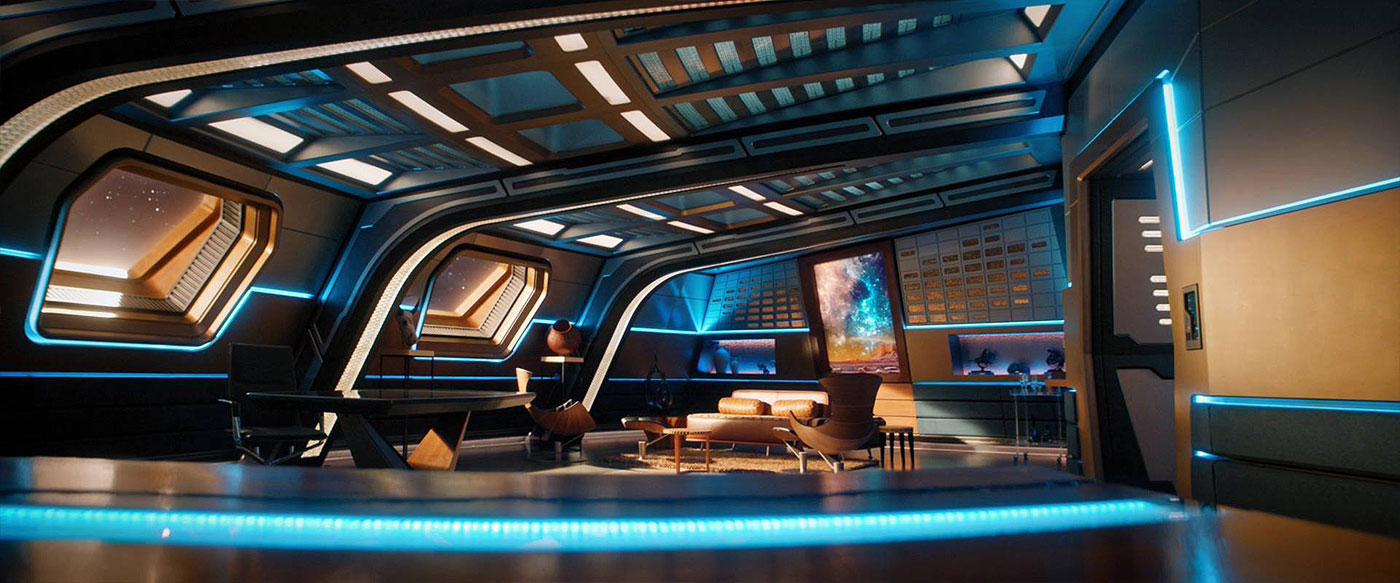
TREKCORE: The show is now being filmed in anamorphic widescreen, which means different lighting, different lenses, etc. – does that change your process for designing new sets?
DEVERELL: Well, a little bit; we had to be more aware of [set heights]. So Pike’s new ready room, for example, we very consciously tightened that up, to keep it on the long-and-narrow, so it looked great for the anamorphic lens. Also for the Section 31 ship, we were very aware of how we were going to be seeing that set, across the expanse [in the middle].
TREKCORE: Speaking of Captain Pike’s ready room, was that a repurposing of a Season 1 set? It seems similar to the Shenzhou ready room build from last year.
DEVERELL: Pike’s ready room was a totally new build. With that, I wanted to remain true to the Discovery [aesthetic], but also create something that was new and special, and very personal to the Pike character. It’s very much a character set.
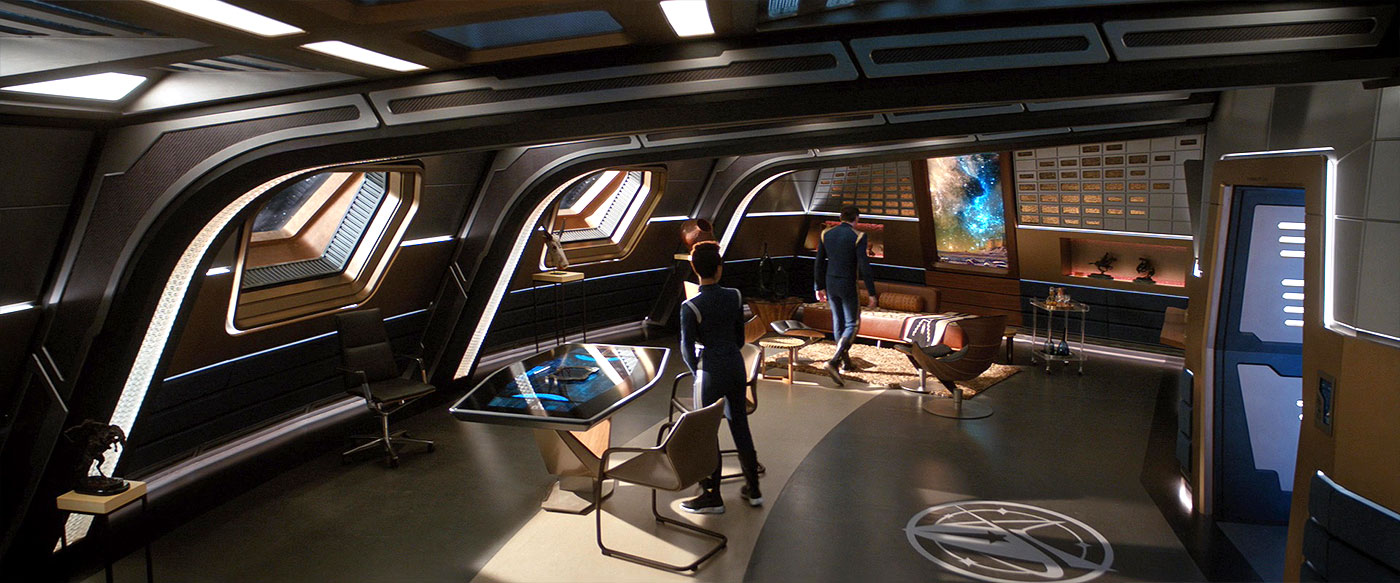
TREKCORE: Did Pike’s southwestern background come into play for that design?
DEVERELL: That was very much a conversation I had with the writers. That’s part of my job, the what-do-the-writers-want, the who-are-the-characters piece, what is Pike’s history?
Pike is from the Mojave desert, so there are a lot of nods to his background and childhood. There’s a table that we built, that has a lightning strike in it, that he either replicated or he had beamed over, this special table. So his room is really about bringing his character and his history alive.
I wish there had been more time to delve into that, because originally there as more backstory for him that was unfortunately cut from the show. But I still think it was there in the design flair; the whole idea was to make it homey and comfortable, like, “This is a chair from my house,” and “This is my table.”
It wasn’t just another room – and it was so very different from Lorca’s ready room, and I think that told everybody we were in a different world with Captain Pike.
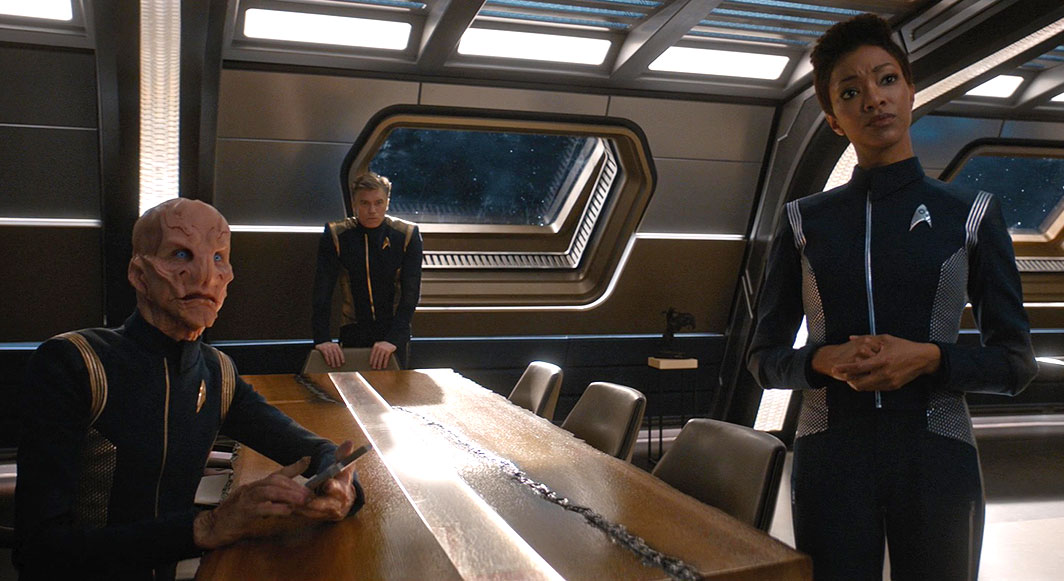
TREKCORE: And Lorca’s ready room was converted into Burnham’s new science lab, right?
DEVERELL: Yes, and though we had a lot of conversations about why she should have a science lab, it’s not really “her” lab. We had conversations about how it shouldn’t be specific to Burnham, but to remake that room into something that we could use for any character – someplace characters could go that wasn’t an office and was more private than being on the bridge.
From a technical standpoint, shooing in Lorca’s ready room was difficult as it was very small, and only had that one piece of furniture in the standing table, so we expanded that set.
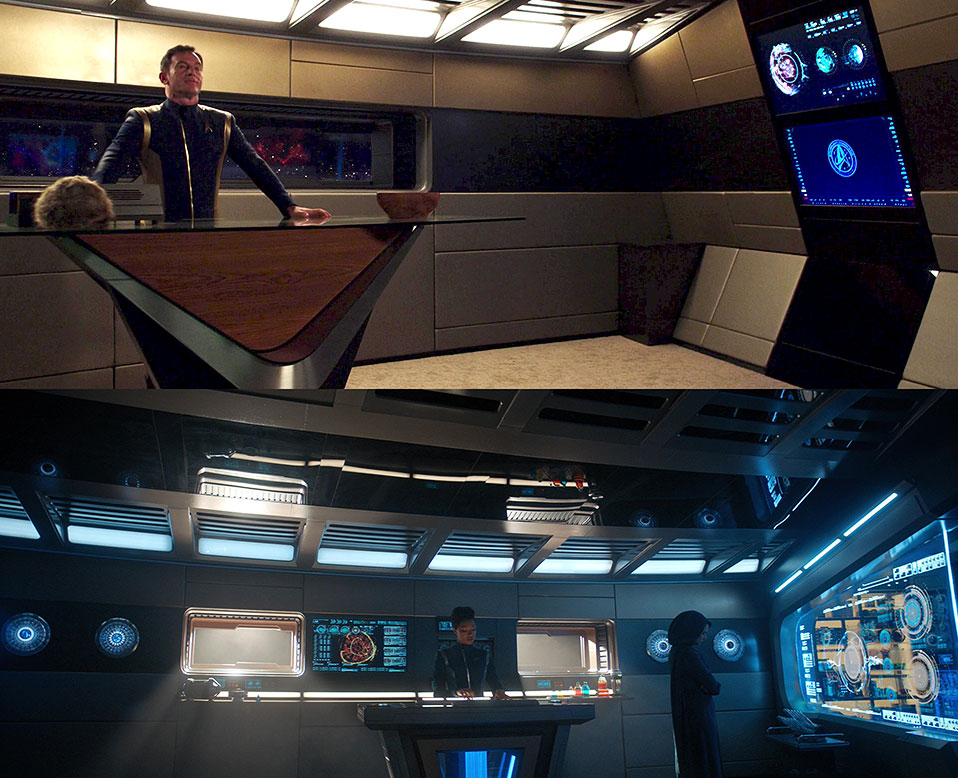
TREKCORE: The biggest redesign we noticed was the conversion of the raised Shenzhou bridge set into the new Section 31 command center.
DEVERELL: That set was fantastic as the Shenzhou, and I didn’t want to tear it down! The whole set originally had a glass floor – because the bridge on the Shenzhou was on the bottom of the ship, looking down into space, which was so awesome.
Just the aesthetics of it, too, related to a Section 31 look, with a lot of sharp angles, and we made it even darker. We took out the floor, opened it up, added stairs down, and created this whole other area down below – and we added in little nooks, built a corridor so people had places to go, a place to transport in, places where things can happen.
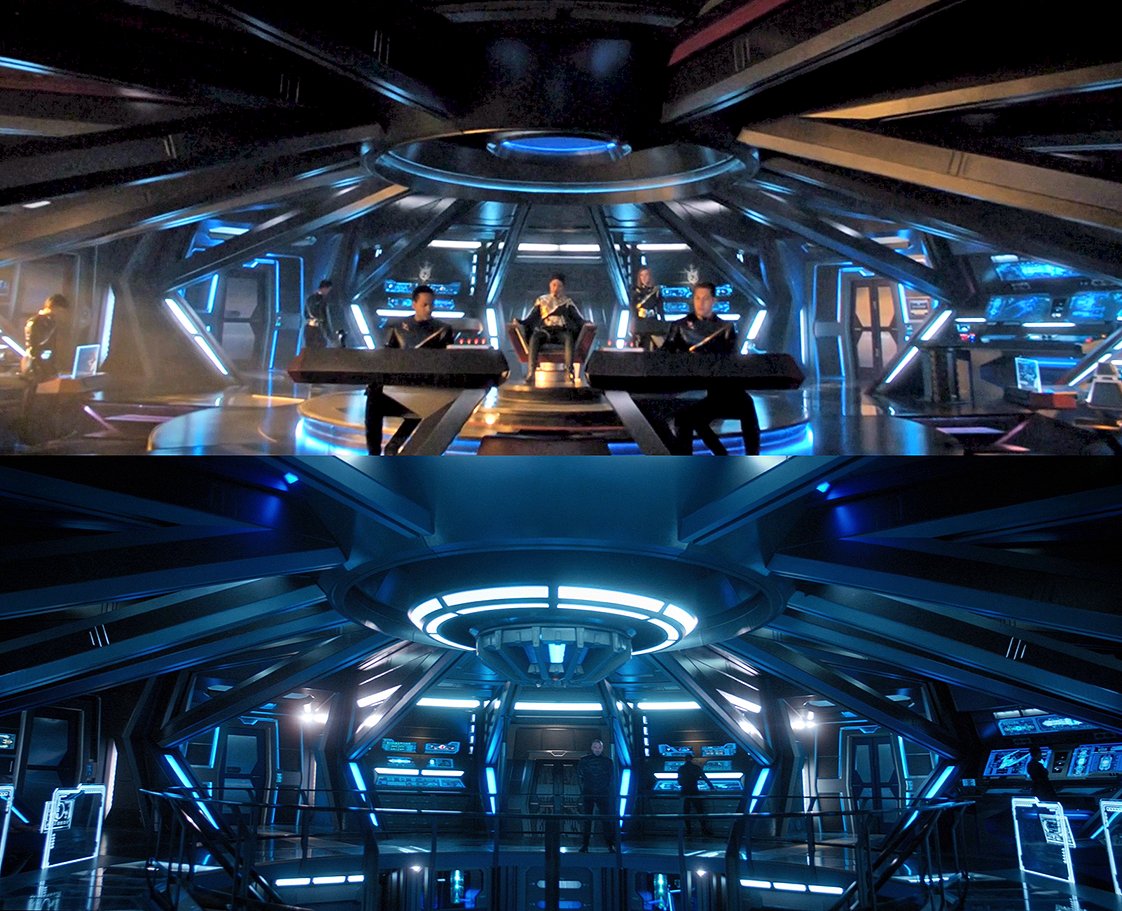
TREKCORE: What about the ‘black ops’ element to Section 31, how did that influence things?
DEVERELL: The first thing I did when they told me Section 31 was coming was to go online and research what shows it had been in, what the sets looked like – but aside from one very small area, there were no Section 31 sets! There were characters, but nothing really for me to draw from.
So we started looking at a lot of film noir, a lot of high-contrast, very stealth things. We used a lot of black and grey and blue, and stuck monitors weird places in the floors, making the sets seem mysterious and very hard-edged. We also did louvres so they could put in backlighting, to allow slashes of light to come through, which you’ll see.
TREKCORE: What can you tell us about the new Klingon sets we saw in “Point of Light?”
DEVERELL: We had the standing Klingon set from the end of last season, the shrine to Molor, and it already had many layers of plaster and paint, and the rocky look, so we built L’Rell’s set off of that.
And I thought, let’s do something different with that cave-like space, and make give her a courtyard garden going in, because the director was looking for place where people could sneak in and out, like how Georgiou appears [in the episode].
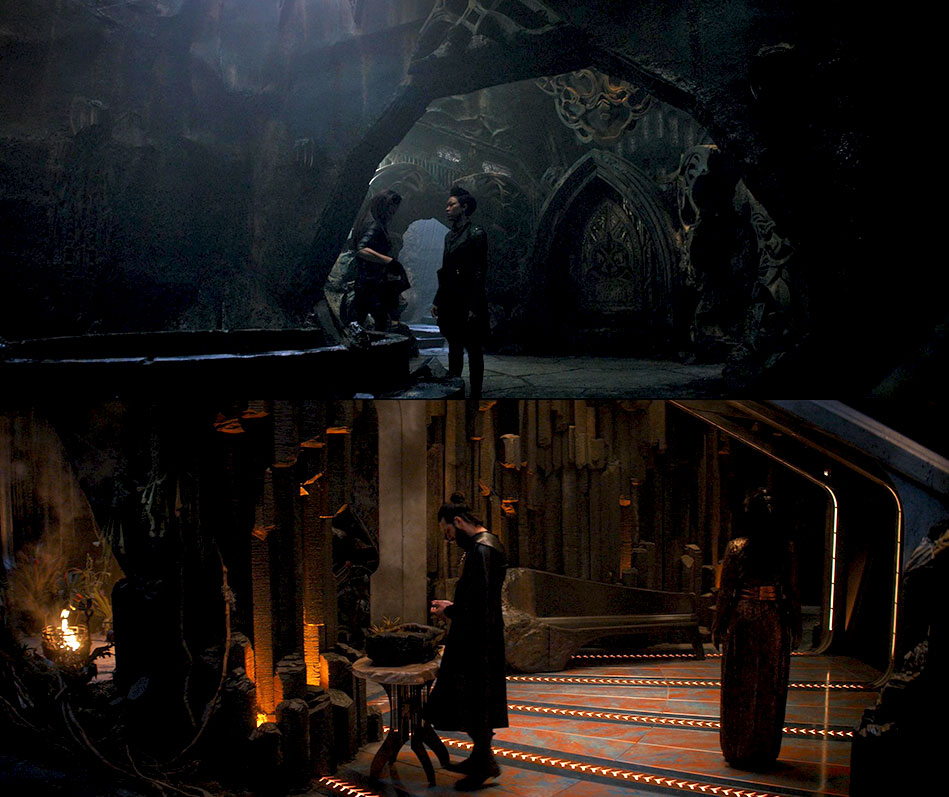
It was a tight space, and not an ideal set. It was hard to shoot in, I know that, because we were so jammed into that studio space, having added on [to the original set]. I don’t know if we’d do it that way again, but we had a lot of fun, while being a lot of hard work.
We made Klingon plants for the garden – we literally had a group of people putting them together and creating these plants, painstakingly painting them. We used things like women’s hair combs to make giant teeth… these are details you don’t necessarily see when you watch the show, but they were there.
And it was L’Rell’s space, so as a female Klingon, I sort of felt that giving her a garden was something that gave us a sense of her character – that she was a mother, that she was a woman, and that Klingons still have nature. Not everything has to be rock. It was like her wardrobe, giving her a softer look.
TREKCORE: Have you been approached to work on the upcoming Picard series?
DEVERELL: No, that’s already well underway; Todd Cherniawsky who was the supervising art director of Discovery and then took over [production design] is doing that one. I’ve seen some of the designs, it’s super exciting; a lot of the same people are working on it.

At this point, ‘Discovery’ art director Jody Clement joined the conversation.
TREKCORE: As a Toronto resident, we got really lucky having Discovery here. The studio is just 10 minutes away from my home, I pass it all the time.
DEVERELL: And it’s an amazing show to work on; it’s really a happy family. There really is a great feeling about it, because it’s ultimately about the classic themes of good over evil, and peaceful discovery and looking to the future.
TREKCORE: You really get that feeling when you talk to the cast, too.
DEVERELL: Especially Sonequa [Martin-Green]. She comes to the set, and is like “Good morning!” and hugs everybody. I’m not often there, but getting a hug from Sonequa is a smile in your day.
JODY CLEMENT: We have something called crew appreciation, which we have every day on the set. It was started last season by one of the directors, John Scott [who did “Si Vis Pacem, Para Bellum”], and Sonequa made sure that we kept that tradition going this season, every morning.
What happens is that the person being appreciated, the next day, they have to appreciate somebody else [from the crew] that’s not in their department – so if it’s a grip today, perhaps they show appreciation for someone in the makeup department, and that person gets to be the star for the day. It can’t be any of the cast, it has to be somebody in the crew, working on the floor.
Here’s the Star Trek Art Department team as they say good bye to the Sarcophagus… sad day! pic.twitter.com/uLlH1RIKxr
— Tamara Deverell (@tamaradeverell) March 28, 2018
DEVERELL: We actually ran out of new people, so the started giving it to the rest of us, who aren’t on the floor, like people in the art department or costuming. So it was given to me, and then I gave it to [costume designer] Gersha [Phillips], it’s super fun.
CLEMENT: You get this big homemade medallion…
DEVERELL: This “I’m the boss for the day!” thing.
CLEMENT: …and Sonequa made it!
DEVERELL: And everybody gets it; there’s not one member of the crew who isn’t appreciated. It’s like a spoonful of sugar.
CLEMENT: I also have to say that I’m very proud of the diversity in our art department. We have designers from Iran, from Columbia…
DEVERELL: …from Scotland; such an amazing mix of ages, men and women, people from all over the place.
CLEMENT: I think we even have a couple of aliens in the department. (Laughs) I won’t say who!
DEVERELL: Our art department is the diaspora that is the show, right? In a weird way, we are the universe.
![]()
Star Trek: Discovery returns this week with “Saints of Imperfection,” airing on Thursday on Space and CBS All Access, and Friday on Netflix.
